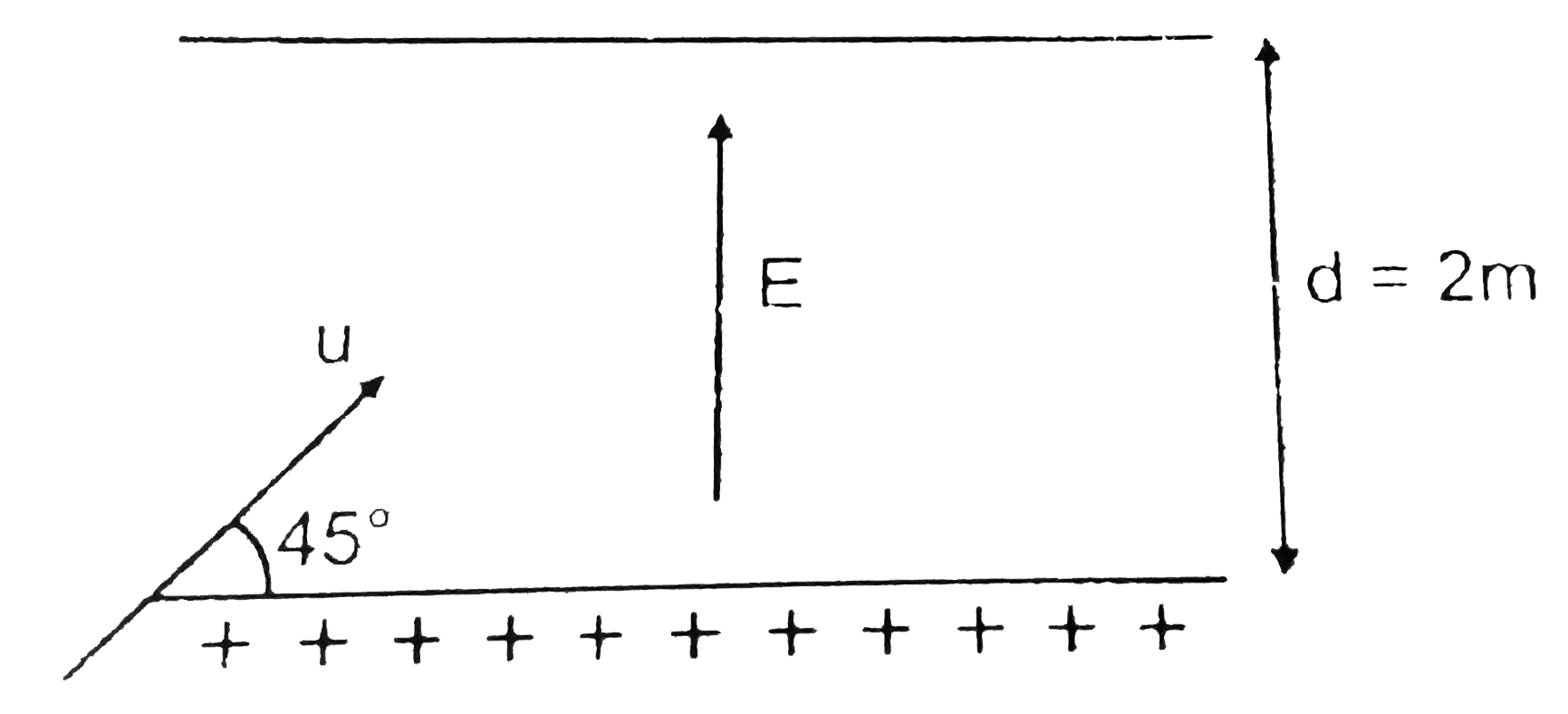An electric field E is produced between two parallel plates having a separation d as shown.
(a) With what minimum speed should an electron be projected from the lower plate in the direction of field so that it may reach the upper plate ?
(b) Suppose the electron is projected from the lower plate with the speed calculated in part (a). The direction of projection makes an angle of 60∘with the field. Find the maximum height reached by the electron.
(c ) After how much time , the electron again strikes the lower plate ?
(d) Horizontal distance travelled by the electron in time calculated in part (c).
Charge on electron : e ,mass of electron : m, consider only electric force.
(a) Force on electron F=eE, in downward direction.
Let the electron be thrown with speed u.
Retardation of electron a=eEm
The electron just reaches the upper plate i.e. its velocity at upper plate is zero.
v2=u2−2as
0=u2−2eEdm⇒u=√2eEdm
Note : This problem is similar to motion under gravity ,here g=eE/m.
(b) This is the case of motion in a plane and similar to projectile motion , here g=eE/m.
y-direction : Velocity of electron at highest point =0.
v2y=u2y−2ays
when s=Hmax,vy=0.
0=(usin30∘)2−2eEmHmax
Hmax=u2sin230∘2eE/m=2eEdm.14.12eE/m
=d4
(c) O to A : Displacement in y-direction is zero.
y=uyt−12ayt2
0=usin30∘t−12ayt2
t=2usin30∘ay=2√2eEdm.12.1eE/m
=√2mdeE
(d) Distance OA:x -direction
x=uxt=ucos60∘t
=√2eEdm.12√2mdeE=d
Note : This case is similar to projectile motion , maximum height , time of flight and range are being asked.



Topper's Solved these Questions
Similar Questions
An electric field of magnitude 1000NC−1 is produced between two parallel platees having a separation of 2.0 cm as shown in figure(29.E4) (a) What is the potential difference between the plates? (b) With what minimum speed should an electron be projected from the lower plate in the direction of the field so that it may reach the upper plate? ( c) Suupose the electron is projected from the lower plate with the speed calculated in part (b) . The direction of projection makes an angle of 60∘ with the field. Find the mazimum height reached by the electron.

View SolutionAn electric field of magnitude 1000NC−1 is produced between two parallel platees having a separation of 2.0 cm as shown in figure(29.E4) (a) What is the potential difference between the plates? (b) With what minimum speed should an electron be projected from the lower plate in the direction of the field so that it may reach the upper plate? ( c) Suupose the electron is projected from the lower plate with the speed calculated in part (b) . The direction of projection makes an angle of 60∘ with the field. Find the mazimum height reached by the electron.

View Solution
Knowledge Check
The electric field (→E) between two parallel plates of a capacitor will be uniform if.
Athe plate separation (d) is equal to area of the plate (A)Bthe plate separation (d) greater when compared to area of the plate (A)Cthe plate separation (d) is less when compared to area of the plate (A)D2 (or) 3An electron is projected with certain velocity into an electric field in a direction opposite to the field. Then it is
AacceleratedBretardedCneigther accelerated nor retardedDeither accelerated or retardedAn electron of kinetic energy K is projected between two charged plats at an angle 60∘ as shown in figure. If electrons doesn't reach to the upper plate just before striking then the magnitude of electric field will be more than:
 AKedB2KedCK2edD3K4ed
AKedB2KedCK2edD3K4ed
A uniform electric field E is created between two parallel
., charged plates as shown in figure . An electron
. enters the field symmetrically between the plates with a
. speed v_(0)'. The length of each plate is l. Find the angle of
. deviation of the path of the electron as it comes out
. of the field.

View SolutionA uniform electric field E is created between two parallel
., charged plates as shown in figure . An electron
. enters the field symmetrically between the plataes with a
. speed v_0. The length of each plate is l. Find the angle of
. deviation of the path of the electron as it comes out
. of the field.

View Solution
An electron is projected as shown with speed u. If electron just fails to strike the upper plate, find range. (distance from starting point at which electron strike the lower plate again). Consider only electric force.
View Solution
An electron is projected as shown with speed u. If electron just fails to strike the upper plate, find range. (distance from starting point at which electron strike the lower plate again). Consider only electric force.
View SolutionA uniform electric field E is created between two parallel charged plates as shown in figure . An electron enters the field symmetrically between the plates with a speed v0. The length of each plate is l. Find the angle of deviation of the path of the electron as it comes out of the field.

View Solution
